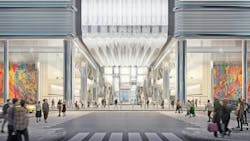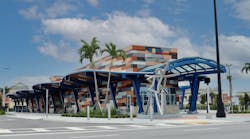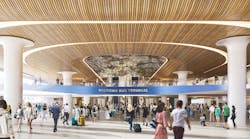FTA publishes draft of environmental impact statement for PANYNJ’s Midtown Bus Terminal replacement
The Federal Transit Administration (FTA) has published the draft environmental impact statement for the Port Authority of New York and New Jersey’s (PANYNJ) Midtown Bus Terminal replacement. The FTA also released revised project plans in response to feedback from key stakeholders, including commuters and the surrounding community.
The new Midtown Bus Terminal will replace the existing 73-year-old terminal. PANYNJ says reliable and efficient bus service between New York and New Jersey is critical to the interconnected economies of both states, as thousands of New Jersey residents work in New York City. The new terminal is designed to meet projected 2040-2050 commuter growth, provide a best-in-class customer experience that serves the region’s 21st century public transportation needs and enhance the surrounding community.
The $10 billion facility will include a new 2.1 million square foot main terminal, a separate storage and staging building and new ramps leading directly into and out of the Lincoln Tunnel. The revised project plan — including a proposal for the permanent closure of a portion of 41st St. between 8th and 9th Ave., a central main entrance, more street-level retail and a multi-story indoor atrium and new public open space — will enhance both the commuter and community experience. The project is expected to create approximately 6,000 good-paying union construction jobs.
“Millions of New Yorkers rely on the Midtown Bus Terminal every year and this plan reflects a bold vision to make this facility a world-class transit hub,” said New York Gov. Kathy Hochul. “Today, we are advancing the revised project plan, which will create a more spacious and welcoming environment for passengers throughout the terminal.”
“A magnificent new Midtown Bus Terminal cuts to the core of the Port Authority’s mission by knitting together New Jersey and New York to create an even stronger, more economically vital and easily accessible region,” said PANYNJ Chairman Kevin O’Toole. “We are replacing what’s been a commuters’ nightmare for decades with what will be a beautiful, efficient new bus terminal that will be the world-class gateway our region deserves.”
PANYNJ's plan for the Midtown Bus Terminal replacement project outlined in the draft environmental impact statement reflects public feedback from extensive community outreach, including input from New York City, commuters, local community boards and elected officials in both states. The draft environmental impact statement has been prepared to permit construction of a full three-part building plan, which includes a main terminal, a storage and staging facility and new ramps directly into the Lincoln Tunnel that bring a wide array of community benefits, including:
- Added capacity to allow curbside inter-city buses that currently pick up and drop off on city streets surrounding the bus terminal to move their operations inside the bus terminal and off the streets.
- The creation at the end of construction of 3.5 acres of publicly accessible green spaces on PANYNJ property by decking over the currently below-grade Dyer Avenue “cut” and building open space on top of the new deck-overs.
- New concessions and retail amenities that will be accessible from the streets in the community, as well as from inside the bus terminal.
- The construction of significantly improved and attractive facades, enhancing the visual quality of the new bus terminal to become an asset rather than an eyesore to the surrounding neighborhoods. The design includes an iconic atrium entrance on 41st St. and 8th Ave.
To deliver the enhancements (which have added to the cost of the project), PANYNJ is engaged in ongoing discussions with the city of New York to use a financing vehicle associated with plans for commercial development above the new terminal via contribution of payments in lieu of taxes (PILOTs), similar to what was done successfully in the building of the Moynihan Train Hall in Penn Station. PANYNJ is also well along in the application process of a federal Transportation Infrastructure Finance and Innovation Act loan to support the project. The updated proposal and PANYNJ’s efforts to secure the needed funding have received overwhelming support from elected officials, whose districts include the bus terminal, as well as from community leaders.
The new bus terminal will be built for the future and designed to be net-zero emissions, serving all-electric bus fleets and implementing 21st century technology at every turn. A traffic management system — including sensor-based monitoring systems — will enable quicker, smoother movement of buses into and out of the new terminal and provide remote monitoring of bus engines to reduce breakdowns in express bus lanes. The building will also include visionary sustainability and resiliency measures, from LEED certification and clean construction to onsite renewable energy, zoned heating and cooling systems and heat recovery and reuse technology.
PANYNJ’s construction plan for the new bus terminal is being developed with input from carriers, customers, the local community, world-renowned engineering and construction experts and innovative architectural and design firms. Current plans provide for a phased construction approach, with the staging and bus storage facility to be built first so it can serve as a temporary terminal while the existing terminal is demolished and rebuilt. The proposal has eliminated the taking of private property, as it would be built on existing PANYNJ property stretching as far west as 11th Ave.
The issuance of the draft environmental impact statement by the FTA, as part of the federal environmental review required under the National Environmental Policy Act, will be followed by a 45-day public comment period and public hearings. Following receipt of public comments, a final environmental impact statement will be prepared and published by the FTA. A decision on the proposal would follow in the form of a federal record of decision, which is targeted for later in 2024. The project is expected to be constructed in phases, with a temporary terminal and new ramps completed in 2028 and the new main terminal completed in 2032.
“Today we’re taking a major step forward to transform what is the worst infrastructure eyesore in the nation and replace it with a best-in-class facility. The Port Authority’s goal is to bring to the project the same perspective we have brought to our airport transformation projects. Transportation hubs are gateways; they symbolize the region to visitors and residents alike. The new bus terminal will be an inspiring gateway to the city that commuters will actually look forward to using and that will serve also as an attractive asset to the surrounding community,” said PANYNJ Executive Director Rick Cotton. “We appreciate the hard work on the part of the Federal Transit Administration in carrying out the environmental review and we look forward to completing our ongoing discussions to reach agreement with the city of New York on the contribution of the PILOT payments related to our commercial development, as we work to secure funding for this critical project that will serve as an economic engine for decades to come.”
“RPA is thrilled to see the advancement of the Port Authority Bus Terminal overhaul, having engaged with the Port Authority on potential alternatives for the project for many years,” Regional Plan Association President and CEO Tom Wright said in a statement. “More than just transporting people, the bus terminal serves as an engine that can boost the economic vitality and competitiveness of the entire region and we are pleased to see a vision for the project that will create a civic destination that also serves as an urban hub. Congratulations to Gov. [Phil] Murphy, Gov. Hochul, Mayor [Eric] Adams and the Port Authority for reaching today's crucial milestone. We look forward to advocating for this project's completion for years to come.”





